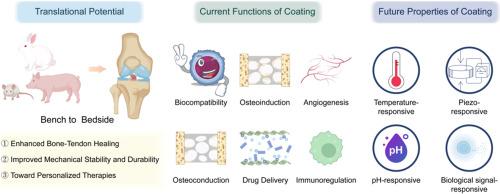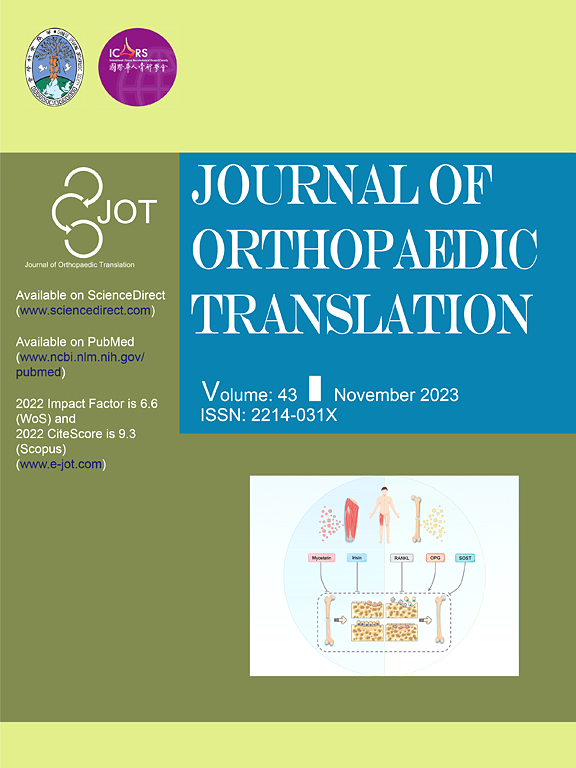前交叉韧带重建中的人工韧带:pet基材料的涂层策略
IF 5.9
1区 医学
Q1 ORTHOPEDICS
引用次数: 0
摘要
人工韧带作为前交叉韧带重建(ACLR)的重要植入物,在早期恢复运动方面具有显著的优势。然而,目前临床ACLR中使用的大多数人工韧带都是由聚对苯二甲酸乙二醇酯(PET)制成的,PET是一种聚合物,其表面光滑疏水,限制了细胞粘附和组织生长,导致肌腱-骨界面形成纤维疤痕组织。为了解决这些限制,已经开发了各种表面涂层策略,包括生物相容性,组织诱导,骨传导,药物传递和免疫调节涂层。这些方法提高了生物性能,促进了韧带化,并加强了与宿主组织的整合。此外,复合功能涂料和智能响应涂料的应用为未来的研究提供了新的方向。尽管有很好的临床前结果,但大多数研究仍停留在动物实验阶段,其潜在机制有待进一步研究。本文综述了人工韧带涂层策略的最新进展,重点介绍了其功能分类、技术发展和临床应用潜力。为了解决人工韧带应用中的关键挑战,如生物相容性有限和组织整合不良,有必要了解目前的研究进展。本文综述了用于韧带的涂层的全面概述,强调了表面改性在提高种植体性能方面的重要作用。为提高ACLR人工韧带的临床成功率和远期疗效提供了有价值的见解,具有重要的临床转化潜力。本文章由计算机程序翻译,如有差异,请以英文原文为准。

Artificial ligaments in anterior cruciate ligament reconstruction: Coating strategies for PET-based materials
Artificial ligaments, as an important implant for Anterior Cruciate Ligament reconstruction (ACLR), offer notable advantages in early return to sport. However, most artificial ligaments currently used in clinical ACLR are made of polyethylene terephthalate (PET), a polymer characterized by a smooth and hydrophobic surface that limits cell adhesion and tissue growth, leading to the formation of fibrous scar tissue at the tendon-bone interface. To address these limitations, various surface coating strategies have been developed, including biocompatible, tissue inductive, osteoconductive, drug delivery, and immunomodulatory coatings. These approaches improve biological performance, promote ligamentization, and enhance integration with host tissues. Additionally, the application of composite functional coatings and smart responsive coatings offers new directions for future research. Despite promising preclinical results, most studies remain at the animal experiment stage, and the underlying mechanisms need further investigation. This review summarizes recent advances in coating strategies for artificial ligaments, highlighting their functional classification, technical development, and potential for clinical translation.
Translational potential statement
To address key challenges in the application of artificial ligaments, such as limited biocompatibility and poor tissue integration, it is essential to understand the current research progress. This review provides a comprehensive overview of the coatings used for ligaments, highlighting the promising role of surface modification in enhancing implant performance. It offers valuable insights for improving the clinical success rate of artificial ligaments and their long term effectiveness in ACLR, thus holding significant clinical translational potential.
求助全文
通过发布文献求助,成功后即可免费获取论文全文。
去求助
来源期刊

Journal of Orthopaedic Translation
Medicine-Orthopedics and Sports Medicine
CiteScore
11.80
自引率
13.60%
发文量
91
审稿时长
29 days
期刊介绍:
The Journal of Orthopaedic Translation (JOT) is the official peer-reviewed, open access journal of the Chinese Speaking Orthopaedic Society (CSOS) and the International Chinese Musculoskeletal Research Society (ICMRS). It is published quarterly, in January, April, July and October, by Elsevier.
 求助内容:
求助内容: 应助结果提醒方式:
应助结果提醒方式:


